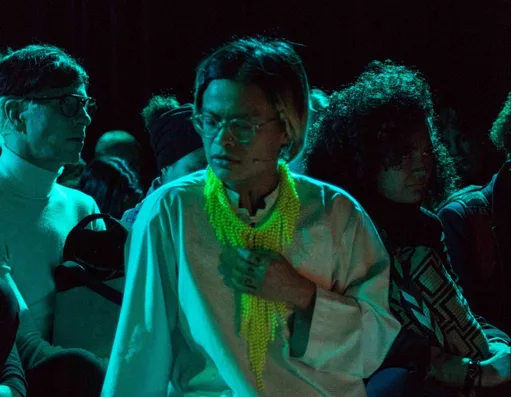This short episode sits alongside the conversation between Raoni Muzho and Phoebe Osborne. The audio here contains a sighing practice that is led by Raoni, and which Rajni, Raoni and Phoebe all took part in during their conversation in October 2023. We recommend that if you are able, you do the sighing practice before listening to the full episode. For the full conversation episode, please go here .
Climate Imaginaries at Sea speculates possible futures in and around water through various artistic and participatory research practices. Three collaborating research groups bring the project forward: at the (GRA), the Lectorate of the Academy of Theatre and Dance at the Amsterdam University of the Arts (AHK) and the at the Amsterdam University of Applied Sciences (AUAS).
The research groups work in partnership with ARIAS, a platform for artistic research in Amsterdam, and a network of partners that includes Tolhuistuin, the Institute for Sound & Vision and CoECI – Centre of Expertise for Creative Innovation.Starting in 2023, three newly developed artistic research studios will invite artists to develop artistic imaginaries that address rising sea levels. The artistic research studios will pay particular attention to perspectives often missing from mainstream climate change debates: material, indigenous, and interspecies inquiry.
Each studio will work without predetermined disciplinary boundaries through practice-led artistic research and written and non-textual forms such as installations, sounds, movements, images and objects. In addition, students will be actively involved in the research by developing imaginative engagements with rising sea levels as both a future prospect and a present reality in various parts of the world.Imagining the future of climate change is crucial for accepting change, whether in our personal lives, environment or politics. As the author Amitav Ghosh points out, “the climate crisis is also a crisis of the imagination.” Who has the privilege to imagine the future of climate change, and for whom are its effects already present? Acknowledging an unequal present where rising sea levels affect low-income populations and people of colour the hardest is crucial, as those communities are also the most vulnerable and the ones with the lowest amount of emissions responsible for the climate crisis.
The research groups work in partnership with ARIAS, a platform for artistic research in Amsterdam, and a network of partners that includes Tolhuistuin, the Institute for Sound & Vision and CoECI – Centre of Expertise for Creative Innovation.Starting in 2023, three newly developed artistic research studios will invite artists to develop artistic imaginaries that address rising sea levels. The artistic research studios will pay particular attention to perspectives often missing from mainstream climate change debates: material, indigenous, and interspecies inquiry.
Each studio will work without predetermined disciplinary boundaries through practice-led artistic research and written and non-textual forms such as installations, sounds, movements, images and objects. In addition, students will be actively involved in the research by developing imaginative engagements with rising sea levels as both a future prospect and a present reality in various parts of the world.Imagining the future of climate change is crucial for accepting change, whether in our personal lives, environment or politics. As the author Amitav Ghosh points out, “the climate crisis is also a crisis of the imagination.” Who has the privilege to imagine the future of climate change, and for whom are its effects already present? Acknowledging an unequal present where rising sea levels affect low-income populations and people of colour the hardest is crucial, as those communities are also the most vulnerable and the ones with the lowest amount of emissions responsible for the climate crisis.
research group
Art & Spatial Praxis
Art & Spatial Praxis
project
Climate Imaginaries at Sea
Climate Imaginaries at Sea



